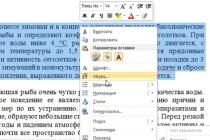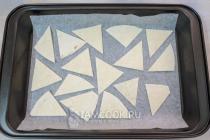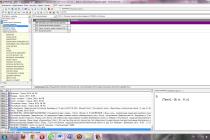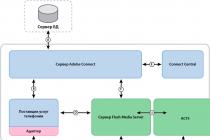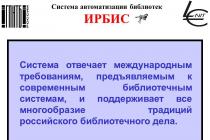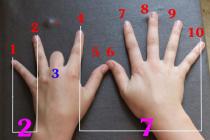The easiest way to create a selection in Adobe photoshop- this is to use Quick mask mode - Quick Mask.
Besides, in Adobe photoshop to select a part of the image, you can use any of the selection tools: Rectangular marquee / Rectangular selection, Elliptical marquee / Elliptical selection, Lasso / Lasso, Polygonal Lasso / Polygonal lasso, Magnetic Lasso / Magnetic lasso, Magic Wand / Magic wand.
The Rectangular marquee and Elliptical marquee tools on the toolbar are hidden behind a single icon. The toolbar displays the icon of the last selected tool. In order to open the pop-up menu, you need to right-click on the arrow to the right, below this icon.

Lasso Tools / Lasso, Polygonal Lasso / Polygonal Lasso, Magnetic Lasso / Magnetic Lasso on the toolbar are hidden behind a single icon. The toolbar displays the icon of the last selected tool. In order to open the pop-up menu, you need to right-click on the arrow to the right, below this icon.

- Lasso / Lasso
- Polygonal Lasso
- Magic Wand
The tool is designed to create selections freeform.
In order to select an area of arbitrary shape on the image, you must:
The tool is also designed to create freeform selections, but the selection outline consists of straight line segments.
In order to select an area on the image using the Polygonal Lasso tool, you need to:
The tool is designed to select areas of arbitrary shape.
When using the tool Magnetic Lasso it is not required to follow the contour of the selected object very precisely. If the object has a good enough contrast in relation to the surrounding background, then the line of the border of the selection area will itself be attracted to the edge of the object.
To select an area in the image using the tool Magnetic Lasso / Magnetic Lasso necessary:
The tool is designed to select an area with the same or similar color pixels. Tolerance parameters are set using the parameter Tolerance / Tolerance on the options bar for that tool. The higher the value of this parameter, the more colors fall into the selection. The tolerance value changes from 0 to 255. When the Tolerance is equal to 0, an area of the same color is selected, with the tolerance equal to 255, all colors are selected, that is, the entire image.
To select an area of an image filled with one color, you must:
Step 1. Select a tool from the toolbar Magic Wand by clicking on the pictogram.
Step 2. Move the mouse cursor to that point of the image, which should be included in the selection area, and left-click. As a result, a selection outline appears around the point, limiting the area, the color of which matches the color of the specified point, taking into account the tolerance, given by the parameter Tolerance / Tolerance.
The flexibility of using the listed tools is ensured by the fact that the areas allocated by them can be add, subtract from each other, get the intersection of two drawn frames.
In order to add a new selection to the old one, before using the tool, press the SHIFT key on the keyboard and, while holding it, make a selection.
To subtract a new selection from an old one, press the Alt key (Option on Macintosh) before using the tool.
Using the SHIFT and Alt keys together leaves the selection (overlay) of the old and new selection (Shift and Option on Macintosh) selected.
In this lesson we will look at all the possibilities of using the basic selection tools of Photoshop, such as "Area" and "Lasso". If you use them each time only to make a new selection, then you are using only a small part of their capabilities.
We will look at how you can add a selection to an existing selection, how to exclude an area from the selection made, and even how to cross two selections and leave their common part selected.
Once you have learned all the features of the basic selection tools, you will begin to use them to your advantage.
Let's start by considering adding a selection to an already selected area.
Adding a selection to an already selected area
For clarity, I will open a drawing of a fairly simple geometric shape in Photoshop:
Simple geometric shape
I want to select a shape in a drawing using Photoshop's most commonly used selection tool. "Rectangular area"(Rectangular Marquee Tool). To select a tool, I will refer to the toolbar:
Select the "Rectangular Marquee" selection tool from the toolbar
I could also press the key M for quick tool selection.
Let's assume that when working with this tool I can only make a new selection. So how do I select this shape? Hmm ... Let's try! I'll start by selecting the bottom of the shape. It's simple enough:

Select the bottom of the shape using the Rectangular Marquee Tool
So we did it - the bottom of the shape is selected. But at the same time, the square part at the top right remained unselected, so now I will make another selection, this time just the top square. As I select the square, I will start from the left top corner while holding down the key Shift to keep the proportions of the square when selected:

Select the top square part of the shape.
We've done that - the top of the shape is selected. Wait ... where did the previous selection of the lower part of the shape go? It disappeared!
Yes, it was gone. I lost the original selection at the moment when I began to make the second selection, and this is a property of all Photoshop selection tools. As soon as you start making another new selection, the existing one disappears. This means that I cannot select my entire shape. Alas, it is beyond the capabilities of Photoshop to highlight complex shapes ... Thank you for being with us!
But seriously speaking, there is, of course, a way to select our shape, although not in the same way as we did with you - not by alternately selecting its parts. What we need to do is add a new selection to the already selected area. After studying this action, you will be surprised how before you could work in Photoshop without it.
Four basic settings for the selection tool

Four main icons with settings for the selection tool
They may look a little odd, but in reality each of these icons are important because they represent a specific setting for working with our selections. The first icon on the left, which I selected in the picture above, is called "New selection area"(New Selection), and it was she who was initially selected when working in Photoshop. Its purpose is to create a new selection each time. If you never knew about these four settings, you would always use the first icon by default.
The second icon, located directly next to the first, is responsible for the Add To Selection. We will study it further.
Add to selection icon in the tool settings area
With this setting selected, I will add any subsequent selection to the previous selection I made. Let's see how this setting will help us make our shape stand out.
First of all, I will click on the icon "New selection area", since I'm going to select the bottom of the shape again, as I did at the beginning of the lesson:

Select the bottom part of our shape again.
Now the bottom of the shape is selected and I'm going to click on the second icon "Add to selection" to select the entire shape. To quickly select an icon, I just press and hold the key Shift before starting a new selection, without accessing the settings area. As soon as you press the key Shift, you will see a small plus sign in the lower right corner of the cursor, which will mean the selection of the second icon:

Hold down the Shift key to quickly navigate to the Add to Selection icon. In this case, a small plus sign will appear in the lower right corner of the cursor
Let's try to select the top square part again. While holding down the key Shift, I'm going to make another selection of the square section at the top of the shape. This time, I will select not only the upper square part, but also a slightly lower rectangular one, so that the second selection partially coincides with the first:

Make the second selection so that it slightly overlaps the first.
A quick note ... you don't have to hold the key all the time. Shift pressed while you make additional selections. All you have to do is press a key Shift and click with the mouse to start making a selection. Once you start selecting the desired area, you can safely release the Shift key.
Now, after I made the second selection, which should be added to the first, I'll release the mouse button and see what happens:

Thanks to customization "Add to selection" which I applied by just pressing the key Shift, my second selection was added to the first, and the shape, which at first seemed incredibly difficult to select, was selected entirely.
Let's look at an example from real life to see how useful the setting is "Add to selection".
Using the Add To Selection Setting to Select the Eyes
One of the most frequently asked questions I hear is, “How do I highlight both eyes at once? I select one eye using the tool "Lasso" but then when I start to select the second eye, the selection around the first eye disappears. " Let's see how this problem will help us to solve the setting. "Add to selection"... Here's a photo I'll be working with:

Original image
I'm going to pick a tool "Lasso"(Lasso) in the toolbar:
Selecting the Lasso Tool from the Toolbox
I could also press the key to select a tool L.
With the Lasso selected, I'm going to select the left eye first:

Select the left eye using the Lasso Tool
When using normal instrument settings "Lasso" after selecting the left eye (to us the left, her right), if I started to select the right eye, the selection around the left eye would disappear. But not with the setting “ Add to selection "! I'm going to press the key again Shift to quickly select an option, see a small plus sign in the lower right corner of the cursor, and while holding down the Shift key, start selecting the second eye. I don't have to hold the key all the time Shift pressed. Once I start making a selection, I can release it. So I go ahead and highlight the second eye:

Select the other eye using the "Add to selection" setting. It's simple enough
And so we did it! Both eyes are now highlighted thanks to customization "Add to selection".
In the first case, when we used the setting "Add to selection" To select the entire shape, I partially overlapped the selections to create one overall selection. In the eyes example, my selections were detached from each other, but ultimately Photoshop merged them into one selection as well. I could highlight the girl's hair, eyebrows, lips and teeth separately from each other, and since I would use the setting each time "Add to selection" Photoshop would still treat them as one selection.
So, we learned the setting "Add to selection"... Let's now focus on customization.
Before we learn how the setup works Subtract from selection(Subtract From Selection), let's see where we can find it. To do this, go back to the settings area and take another look at the four small icons - settings Subtract from selection third from left:
Icon for setting "Subtract from selected area" in the settings area
Now that we know where the setting is located, let's take a look at how to apply it.
Sometimes, when selecting a complex shape, it is much easier to select the entire shape and then exclude unnecessary parts. Let's go back to our shape, with which we worked at the beginning of the lesson:

In the first case, when I selected the shape, I selected the bottom part of it first, and then I used the setting "Add to selection" for additional highlighting of the upper square part. This time, to show you how the Subtract From Selection setting works, I'm going to first select the entire shape. I will use the tool again "Rectangular area", and quickly make a rectangular selection for the whole shape:

Select the entire shape with the Rectangular Marquee Tool
It seems to work, with the exception of one detail - when selecting the entire shape at once, I also selected the empty area in the upper left corner. Thanks to customization Subtract from selection, I can easily eliminate this miss.
Just like with the setting "Add to selection" to select a setting Subtract from selection you do not need to go to the settings area every time. All you need to do is press and hold the key Alt(Win) / Option (Mac), as a result of which a small minus will appear in the lower right corner of the mouse cursor, which will mean the choice of the setting:

Press and hold Alt / Option to quickly select the Subtract From Selection setting
Using the tool "Rectangular area" and customization Subtract from selection I'm going to select the empty area at the top left and exclude it from the initial selection of the entire shape. While holding down the Alt / Option key, I'll start by selecting the upper-left corner of the empty area, moving slightly away from the original selection, and continue the selection down to the right until I have selected all the empty area that I want to exclude:

Select the area you want to exclude from the initial selection of the shape
As well as when working with the setting "Add to selection", you don't need to hold down the Alt / Option key all the time. All you have to do is press and hold the key until you start the selection with the mouse button. After that, you can safely release the Alt / Option key.
Now, after I have selected the unnecessary area that I want to exclude, I just need to release the mouse button and please:

The empty area at the top of the shape is no longer in the original selection
So, thanks to the setup Subtract from selection the empty area at the top of the shape is no longer in the original selection, and only the shape itself remains selected.
Let's wrap up our exploration of the selection tools' capabilities by examining the setting "Intersection with selection".
Intersection with selection setting
We've seen how to add a selection and how to exclude unwanted areas from it. Now it's time to explore the last setting (Intersect With Selection). First, let's revisit the settings area to find the setting. Intersect selection and then examine its application. Of the four small, but such important icons, the setting we need is the first from the right edge:

Intersection with selected area setting icon in the settings area
As with the previous settings, the setting Intersect selection can be selected by clicking on the icon in the preferences area or by pressing the Shift + Alt (Win) / Shift + Option (Mac) keys. So, let's repeat once again the keyboard shortcut to select our settings:
Shift = "Add to Selection"
Alt (Win) / Option (Mac) = Subtract From Selection
Shift + Alt (Win) / Shift + Option (Mac) = Intersect Selection
After determining how to select a setting Intersect selection, let's look at what she is responsible for. To do this, we need an image of a shape like this:

This figure consists of two red crescent moons located side by side, with an empty white space between them. Let's imagine that we need to select this empty space. You can try to take the tool "Lasso", provided that you can draw perfectly even circles. You can use the tool "Magic wand"(Magic Wand) in this case, since the area we need to select is uniformly white, but what if it were not the same color? What if it was a color photograph and we needed to select part of the shape? Tool "Magic wand" then it would hardly have helped us. So what should you do?
To select round and oval shapes, the program has a tool "Oval region"(Elliptical Marquee Tool). Let's try to use it.
First, I'll select this tool from the toolbar:

Select the "Oval Region" tool from the toolbar
Then by selecting the tool "Oval region", I'm going to make a selection of a circular shape around the left crescent. As I select, I will hold down the key Shift, to keep the shape of the circle:

Select the left crescent with the Oval Marquee Tool. Press the Shift key to keep the shape of the circle when selected.
By selecting the left side of the shape, I also selected the central white area, but my task is to select only the white space inside the shape. You can try using the setting "Add to selection" and make another selection of the right crescent:

Select the right crescent using the "Add to selection" setting
Did not work out! All we have achieved is that both crescent moons are highlighted. Maybe make a selection of the right crescent using the setting Subtract from selection:

Select the right crescent using the "Subtract from selection" setting
Again it did not work! The Subtract From Selection setting helped me get only the left crescent selected, but again, that's not what I wanted. It's time to take advantage of the setting Intersect selection.
Customization Intersect selection works like this: it compares the selection you have already made and the selection you are making at the moment, and only selects the area where the two selections intersect. It turns out if I first selected the left crescent along with the empty area, and then made a round selection of the right crescent using the setting Intersect selection, also including white space in the center, then, ultimately, there would only be a selection of the white area in the center of the shape - the place where the two selections intersect. But this is exactly what I need!
Let's try to select the required area. Having selected the left crescent, I use the tool to "Oval region" make a second selection of the crescent on the right, so that the intersection of the selections is the white space in the center. In doing so, I'll press the keyboard shortcut Shift + Alt (Win) / Shift + Option (Mac). If you look at the lower right corner of the mouse cursor (in the figure it is circled in red), you can see a small cross indicating the choice of the setting Intersect selection:

Select the right crescent using the "Intersect with selection" setting
As with the previous settings, once you start making a selection, you can stop holding down the Shift and Alt / Option keys.
Using the setting Intersect selection, I also highlighted the right crescent. Now the two selected selections intersect in the central white area, which is what I want to ultimately select. All I have to do is release the mouse button, and the program itself will leave selected only the white area in the center of the shape - the intersection of the selections:

We easily selected the white area between the two crescents using the Intersect With Selection setting.
We have completed the task. By setting Intersect selection it was easy for us to highlight the white area between the two crescents.
So, we learned about all the possibilities of Photoshop's basic selection tools. Now we can not only make new selections, but also add selections to an existing selection, exclude unnecessary area from the selection and leave selected only the intersection of several selections. We have reached our full potential! We can embrace the whole world! The prospects are great! We ... Okay, okay, I'm finishing.
Translation: Ksenia Rudenko
Good day to all, my dear friends and readers! How is your mood? I hope everything is OK. And with this good mood I would like to continue our Photoshop tutorials. Today I would like to talk about a very important action in Adobe Photoshop, namely selection of objects, part of an image, etc.
Why do we need to select objects at all? For different purposes. For example, you want to cut some separate part one image and transfer it to another. Or maybe you want to keep a certain part of the image from the whole. Or you just want to work (change, process, apply filters, add brightness, sharpness or other effects, etc.) with a separate part of the image.
Today I want to briefly tell you about different ways selections in Photoshop so that you know what they are and for what cases which one is best suited. Go!
Highlighting an area

For example, if you want to take into circulation something rectangular or square, then it is best to take a tool Rectangular Selection... And if you want to highlight something oval or round, then you are welcome, use "Oval selection".
Lasso

Regular lasso
The instrument is completely at the mercy of your hand, i.e. as you move with your hand, so the selection will be drawn. If your hand is shaking, then the selection line will shake. Is the least useful tool in this group.
Straight lasso
This type of lasso is most suitable for selecting objects consisting of straight lines. It is not necessary that the corners are straight, even if it be a fence. It all comes down to the fact that you are constantly setting checkpoints, thanks to which your current progress will not go astray if you screw up. As a result, the selection is smooth.
But it is not necessary to use it for even images. With it, you can even select people and rounded objects.

Magnetic lasso
This is just a great kind of lasso. It is great for objects with sharp outlines or for objects that differ in brightness and color from the surrounding background.
The principle of its operation is such that you just need to put the first selection point on the edge of the selected object, and then you simply move the mouse along the area that you want to select. At the same time, you do not need to clamp anything and you can not be afraid that you will not lead clearly along the contour, even if your hands are shaking.
The tool itself is magnetized to the edge of the object (hence its name). The main thing is simply not to move too far from this edge, otherwise the lasso will be able to magnetize to the other edge. And so the tool is just awesome.
Fast selection
Another group for selecting objects, the essence of which is to select objects with a couple of clicks.

Magic wand
Tool "Magic wand" allows you to select the desired object in 1 click. The main thing is to correctly set the tolerance level. And of course, you need the edges of the object to be clearly separated from the background, that is, to contrast with it.
Fast selection
Tool "Quick Selection" is a kind of magic wand, but unlike it, we do not just select some area by pressing a button, but we can say we sketch it with the mouse button held down (the tool takes the form of a brush for a reason).

But as in the case of the magnetic lasso and the magic wand, the selected object should contrast against the general background at least somehow.
Quick mask
It has proven itself among photoshoppers. The essence of this tool is that you kind of paint over the desired object or the background around this object. After this deactivation of the mode, a dotted line appears at the edges of the painted area, i.e. selection itself.

This mode is very convenient to use when working with any types of images, even if they will not contrast with the general background. The main thing is just to paint well in the right places.
Feather
Completes our today's list. The principle of its operation is somewhat similar to a rectilinear lasso, only unlike the latter, the lines can be adjusted and rounded.
Another undoubted advantage is that the use of this tool can be interrupted for a while without prejudice to progress. That is, if you have already started selecting an object with a pen, then you can easily switch to another tool, but at the same time your current selection will not go anywhere and you can continue it at any time.

You can see how many ways of selecting objects have a wonderful Adobe program Photoshop? This shows once again how much this graphics editor powerful and comfortable. Each instrument is built differently, but the essence remains the same. And each person can use a certain tool when working with the selection of certain objects or areas of the image.
And we will consider each of these tools separately and in detail, so that you can choose the most interesting for yourself. Or maybe you already have a favorite instrument? Write in the comments which one is closest to your heart).
Well, in general detailed lessons for each tool, and indeed for working with Photoshop, you can look in this wonderful video course... The lessons are simply amazing and are told in simple and understandable language for any level of user. Everything is "chewed" and shown on real examples. After watching of this course you will already be very good at Photoshop. Highly recommend.
Well, for today I am finishing our review lesson. I hope that it became clear to you which method of selecting images is best for what. By the way, do not forget to subscribe to my blog updates, then you will definitely not miss anything interesting and will be aware of the most important points... See you in other articles. Bye Bye!
Best regards, Dmitry Kostin.
If you read my first lessons in Photoshop, then, probably, remember, I briefly told what these or those are intended for. And today we will take a closer look at the tools for selecting different areas in photographs and pictures.
Selection tools in Photoshop are designed to select a specific area in the image and further process it. In other words, you can, for example, select some part of the photo and darken it, while the rest will remain unaffected.
If we look at the toolbar in Photoshop, we will see three "shelves" with selection tools.
But in fact, there are more tools. In order to see the rest, you need to hold down the left mouse button. In this case, they appear in the drop-down list. Holding down the first selection tool, we will see all four: Rectangular area, Oval area, Area (horizontal line), Area (vertical line). These are the most important selection tools.

Below we have: Lasso, Straight Lasso, Magnetic Lasso.

And the third batch of selection tools: Quick Selection and Magic Wand.

Let's create a new document and try to work with these tools.
Click the "File - New" menu.

In the window that opens, indicate the size of the document, 600 by 500. We press "Yes".

The document has been created. Select the Rectangular Marquee Selection Tool. Now we click on the created document with the left mouse button, hold it down, drag the mouse to the side, and stretch it. When the desired area is selected, the mouse will need to be released.

Thus, we have a randomly selected area. If we want the proportions to be preserved during the selection, then all this must be done with the Shift key held down. That's what I did:

We can move this selection throughout the document. To do this, move the mouse cursor over the selection itself, hold down and drag to the desired location.
If we try to create another selection, the first one will disappear. This is how the selection is set by default. But we can correct this in the Options by selecting the second mode " Adding to the selection»Clicking on the corresponding icon.

Now every new selection will remain. And we can also add a selection area to an already selected area.

To remove the selection, select the menu “ Select - Deselect". Or use hotkey Ctr + D.

The rest of the selection tools in this group are similar in their work. For example, the Oval Region. With it, we can select an oval area, or a circle, if we keep the proportions, holding down the Shift key.

Next we have the Lasso tools. The first one is very easy to use, like a pencil, we outline the desired area, and it becomes selected after we release the mouse button. This selection tool is arbitrary.

Next comes the Straight Lasso. The selection proceeds from point to point. We put a point on the document, then the second, third, etc., then we close the last point with the first and we get a selected area. It is most convenient to use it to select some rectangular objects.

And Magnetic Lasso, this tool tries to automatically detect the edges of the object we are trying to select. We will better consider this tool on the example of some picture already. Let's take this camera here.

And let's try to highlight it. To do this, we put a point somewhere where the camera begins, and lead around it. And what we see is that the instrument itself magnetizes and creates points around it. After completely tracing the camera, you need to close the tool with the first point, and the object is selected.

Now we can work with the selected area. Transfer to a new document, reduce, change color and much more.
The next group of tools is Quick Selection and Magic Wand.
With the help of Quick Selection, we can select an object, just kind of painting over the places that need to be selected. It is somewhat reminiscent of the tool we discussed earlier.
And one more tool is the Magic Wand. It highlights the place where we click and adjacent pixels of similar color.
That is, for example, if we have a photo where there is a blue sky, and it is very different in color from other objects, then using Magic wand, it will not be difficult for us to select the sky by clicking on it once with the left mouse button.
With this photo, I did just that:

There is also a couple here important settings in Options. The first is, as with the first selection tool, the selection of a mode, that is, each press will add a new selection, and the old one will disappear, or our selection will be added to what is already there.
And the second is the Tolerance, the larger this value, the more neighboring colors will be affected by the selection. That is, something like sensitivity.

Now let's see how we can apply Selection tools when processing photos. In fact, these tools are used in hundreds of different operations. But we'll look at a few interesting ones.
So let's work with the selected area.
Let's go back to one of the images that we have already opened, and with the help of the selection tool of the Magic Wand, select the sky. And then we will try to change its color. To do this, select the menu " Image - Correction - Hue / Saturation».

Here, using three sliders, you can adjust - Saturation, Hue and Brightness. Move these sliders to get the effect you are interested in. At the same time, you can observe what the result is.
After everything is configured, click the "Yes" button.

See what I got.

The sky darkened!
But as you can see, some areas of the sky were not selected, and remained, as before, bright. This is very noticeable among the green leaves of the trees. In such cases, you need to increase the Tolerance in the Options and uncheck the Adjacent box. pix., which means the selection of the specified color and similar in the tolerance region, throughout the image.

Now I made the color of the sky a little different, and as you can see, increasing the Tolerance and disabling Adjacent. pix... it turned out much better.

With the help of selection tools, such as the Magnetic Lasso, we can cut out the necessary parts from the photo.

And transfer them to other photos, or new documents.

With the eyes selected, using the Oval Marquee tools, you can change their color by going back to the Image - Adjustments - Hue / Saturation menu.

You can simply create selections, then paint over them with the Paint Bucket or Gradient tool.

In general, the scope of the selection is different, and it comes up all the time when working in Photoshop. It is imperative to be able to use the Selection Tools at least at a basic level.
He is in the fourth group together with. They are similar in their principle of operation, so the developers of Photoshop have combined them together.
So, what is this tool and how to work with it - let's figure it out one by one.
What is Fast Selection for?
Working with the tool like a brush, you can select complex areas of the image. It analyzes the pixels that you move the mouse pointer over and then helps speed up the work itself by highlighting areas of the image containing similar pixels.
Thus, Fast selection it is convenient to use when the image is contrasting, that is, a sharp transition between pixel colors is noticeable.
How to use
Let's figure it out on specific example... Let's say the task is to select the entire background of an image.
Step 1
First, I do one click anywhere with the background. Photoshop is by default in the mode New selection(these modes are displayed on), so it will select a small area the size of a brush for now.

Step 2
The second click will be slightly farther from the original location. Photoshop studied the pixels of your first click, and then the pixels of the second click, compared them and saw which pixels are located around. Having quickly analyzed all this, he himself selects an area that contains exactly the same pixels.

The mode changed automatically to. Therefore, we continue to click on new areas of the background.
Step 3
I will make the third click much to the right. As a result, Photoshop immediately showed me "marching ants" around most of the image. Note that apart from the background, nothing else stands out.

Look, three clicks, and almost half of the background is already selected. Isn't this proof that the instrument is not in vain carries the defining word "Fast"?
If not satisfied appearance tool pointer, it can be changed to another standard one. To do this, press the Caps Lock key.
Parameters panel
The general operating principle should now be clear. Now let's move on to the parameters panel, where there are settings that make fundamental changes. This is how it looks:

The meaning of all tool parameters from left to right:
New selection
Tool automatically installed to create a new selection, which is very convenient, since the whole point is just in creating it.
Add to selection
Photoshop automatically switches to this mode when you clicked or made the first brushstroke. The program will now add any additional areas that you click with the mouse.
Naturally, you can manually switch to this mode.
It is better to add new selection areas with single mouse clicks. In such cases, if something does not work out, you can press Ctrl + Z to.
In addition to single clicks, you can hold down the left mouse button and move over areas of the image.
Subtract from selection
Photoshop can choose more than it actually needs. If you have this problem, select this mode and then brush over the area you don't need to exclude it.
To get the most out of the tool, you may have to add and subtract a lot from the selection. Keyboard shortcuts can help speed up this process.
Press and hold the Shift key to enter Add mode.
To switch to the mode Area subtraction press and hold the Alt key.
Brush options
Use a larger brush for large areas and a smaller brush for small or hard-to-reach areas. Click on the small triangle next to the brush size to bring up a menu.
You can also adjust brush hardness, spacing, and tilt from this menu.
For best results, use a stiff bristled brush to create crisp edges (instead of the slightly transparent ones that appear when painting with a soft bristled brush).
Sample from all layers
Initially, this setting is disabled. This means that Photoshop only takes into account the pixels of the active layer. If you check this box, the program will use the entire document and capture all such pixels, no matter what layer they are on.
Reinforce automatically
Since the tool Fast selection creates selected areas very quickly, their edges can end up looking rough and imperfect. To do it more carefully - check this box. The function will make the edges smoother, but if you are working with a very large file, it will take a very long time to process.
Refine edge
I have written about this command more than once. Therefore, I immediately invite you to.
If you spot an error in the text, select it and press Ctrl + Enter. Thanks!

